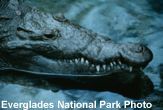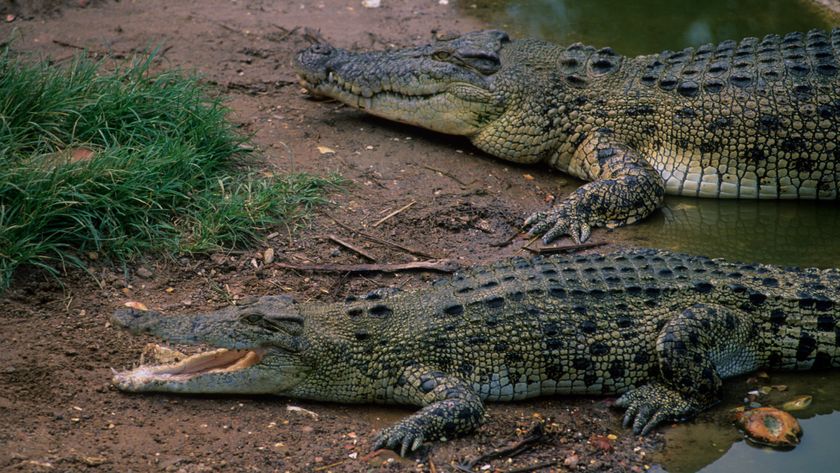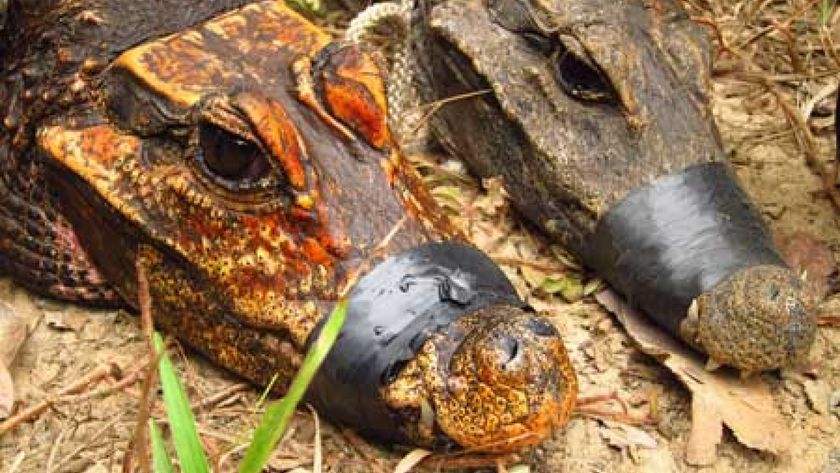Before Crocodiles, the Hairless Coyote

A team of paleontologists has found a missing link between the crocodile family and its small and graceful landlubber ancestors.
The reptile looked like a hairless coyote with scales, says Catherine A. Forster, a paleontologist at Stony Brook University, who is part of a team that analyzed the recently found fossil of what is dubbed Junggarsuchus sloani.
It had "long thin limbs, narrow snout with sharp pointed teeth, moderate tail," and was "out jogging around looking for a meal," Forster said.
Don't be fooled by good looks. This extinct creature also had the classic crocodile muscles in its jaw built for crushing prey. It lived about 210 million years ago.
The findings, co-authored by James M. Clark of George Washington University and Xing Xu and Yuan Wang of the Institute of Vertebrate Paleontology and Paleoanthropology in Beijing, were published in a recent issue of the journal Nature.
The creature is named after the Junggar Basin, a desert region in China where the fossil was found, and after Chris Sloan, a senior editor at National Geographic magazine who found the specimen, Clark said.
Before the discovery of Junggarsuchus, paleontologists had a strong idea that the crocodile family's ancestors included a group of graceful land-dwelling reptiles called sphenosuchians.
Sign up for the Live Science daily newsletter now
Get the world’s most fascinating discoveries delivered straight to your inbox.
Sphenosuchians had pointy teeth and were predatory carnivores, like today's crocodiles and its relatives such as alligators, caimans and gavials (the family can be referred to as crocodylians).
Unlike more evolved crocodylians, which have short legs extending sideways from their torsos, sphenosuchians' longer legs hung down directly beneath their bodies. Their heads were compressed from side to side, rather than top to bottom as in living crocodiles. And they lacked the rigid skulls and broad surfaces for crunching jaw muscles found in living crocs. So the bones evidence for ancestry was murky.
Junggarsuchus now clears that up. The fossil skull has those broad areas for muscle attachment and indicate that the muscle for closing the jaw was significant.
By analyzing the fossil's features and comparing them statistically with features of other reptiles, Clark, Forster and their colleagues determined that Junggarsuchus is a sphenosuchian and the closest ancestor to living crocodylians.
Junggarsuchus was a sight to see. Its hands were in line with its forelimbs, rather than splayed out as in living crocodilians. It had only four toes, with the outer toe curling in toward the others, which were very close together. Junggarsuchus walked on its three functional toes. These features all suggest that the scaley coyote reptile and its small pre-croc relatives never pulled submarine moves and preferred to stalk prey on land.
Crocodylians that moved about in water evolved later, about 140 million years ago.
The discovery of Junggarsuchus also allowed the paleontologists to show that this reptile and its closest relatives represent a phase in the evolution of crocodylians during which the group became highly adapted for living on land.
If the route from scaley coyote to crocodile sounds far-fetched, remember that "everything has to evolve from something else," Forster said. "For example, birds evolved from animals that didn't fly. Whales evolved from animals that lived on land."
Fossil animals often appear unfamiliar because more than 95 percent of all animals that ever lived are now extinct--we've never seen such things.
"When you look at the fossil history of crocodylians, they were very diverse in size, shape, and lifestyle," Forster said. "Living crocs are quite dull by comparison as they are all very similar to one another."
Robin Lloyd was a senior editor at Space.com and Live Science from 2007 to 2009. She holds a B.A. degree in sociology from Smith College and a Ph.D. and M.A. degree in sociology from the University of California at Santa Barbara. She is currently a freelance science writer based in New York City and a contributing editor at Scientific American, as well as an adjunct professor at New York University's Science, Health and Environmental Reporting Program.












